Terrapins are unique among North American turtles because they live exclusively in saltwater-influenced habitats.
The diamondback terrapin (Malaclemys terrapin) inhabits the coastal brackish and saltwater marshes of the eastern and southeastern U.S. It is a medium-sized turtle, with males reaching about 5 inches in carapace length and females significantly larger at 9 inches. Generally, the carapace and skin coloration of a terrapin is gray to whitish, with varying patterns of black spots and streaks. Some even have black “mustaches.” Occasionally, yellow blotches are found on the carapace scutes, and an orange tinge may be present on the marginal scutes of some individuals.
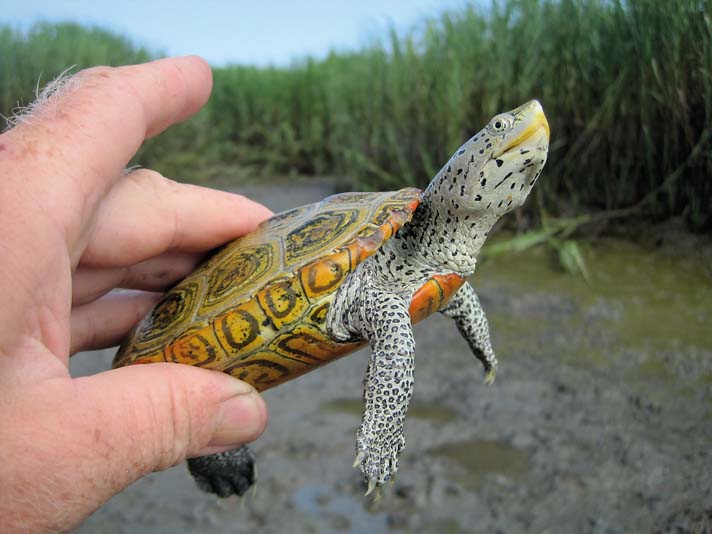
Kurt Buhlmann
When being handled, terrapins aren’t usually known to bite. Still, be careful if handling large females due to their big heads and powerful jaws.
Terrapins are members of the family Emydidae, which includes all freshwater painted turtles, sliders, cooters and map turtles, as well as some others. The diamondback terrapin’s closest relatives are map turtles of the genus Graptemys.
Terrapins are unique among North American turtles because they live exclusively in saltwater-influenced habitats. Adults are often observed in salt marsh creeks at low tide but are less obvious during high tides, a time when large predators such as sharks are more likely to enter the habitat. Turtle biologists suspect that terrapins spend high tide hidden in the grasses and mud of the salt marsh flats, where they also feed on periwinkle snails. Hatchling terrapins seem to occur in grassy mud flats closer to shore and spend their early years hiding in shallow water, mud and under mats of dead grasses.
Seven Terrapin Types
The great variation in the physical appearance of diamondback terrapins has lead to the identification of seven subspecies historically recognized to occur along the eastern U.S. coastal areas from Massachusetts to Texas.
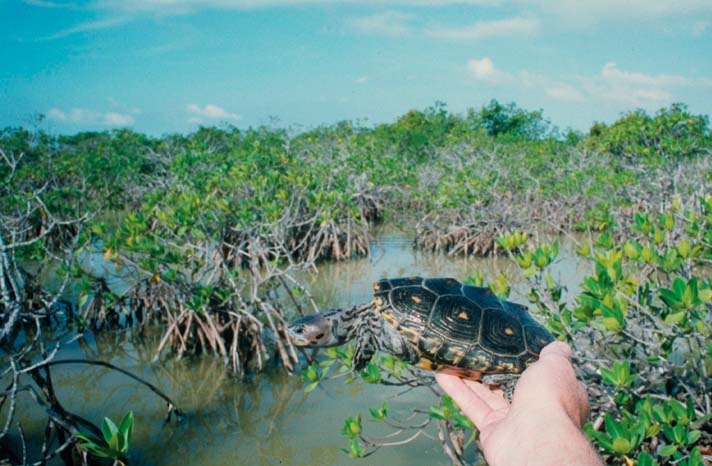
Kurt Buhlmann
This is a mangrove diamondback terrapin (Malaclemys terrapin rhizophorarum) that was found in the Florida Keys.
The northern subspecies M. t. terrapin (found from Massachusetts to Virginia) and Carolina subspecies M. t. centrata (North Carolina to northern Florida) are generally described as having no knobs down the center of the carapace, whereas the other subspecies do. Some females of M. t. centrata seem to have larger heads than the northern subspecies, as well.
The Florida east coast subspecies M. t. tequesta often lacks concentric circles on the carapace scutes, and the mangrove subspecies M. t. rhizophorarum (found in the Florida Keys) has bumps on the dorsal keel and the spots on the neck appear as streaks. The ornate subspecies M. t. macrospilota (found in western Florida) has large yellow or orange blotches on the carapace in the center of each scute, and the Mississippi subspecies M. t. pileata may exhibit brown carapace coloration and the Texas subspecies M. t. littoralis (found from Louisiana to eastern Texas) has a very white head.
Read More
Breeding Diamondback Terrapins
Diamondback Terrapin Species Profile
Variability in the color patterns and appearance of diamondback terrapins can be rampant within a single population, even over only a few miles of salt marsh coastline. Historical farming of terrapins for food in the early 1900s, especially in the Chesapeake Bay region of Maryland and Virginia, may have lead to the mixing of terrapins from many regions, and has been further suggested by recent genetic studies. The subsequent release or escape of these stocks may have contributed to the extensive local variation seen today.
Where to Observe Terrapins
For beach-goers from Cape Cod, Massachusetts to Padre Island, Texas, the opportunity to observe one of the most unique North American turtles, if one is observant, is greatest from May through July, when female diamondback terrapins are often seen on land as they search for nesting sites. Most beaches are on coastal barrier islands, and access means crossing the causeways that span salt marshes between the mainland and each island. Those salt marshes are the home of the diamondback terrapin. At this time, travelers also have the opportunity to either be turtle conservationists by being alert to avoid hitting a road-crossing terrapin, or contribute to their mortality and population decline by doing the opposite.
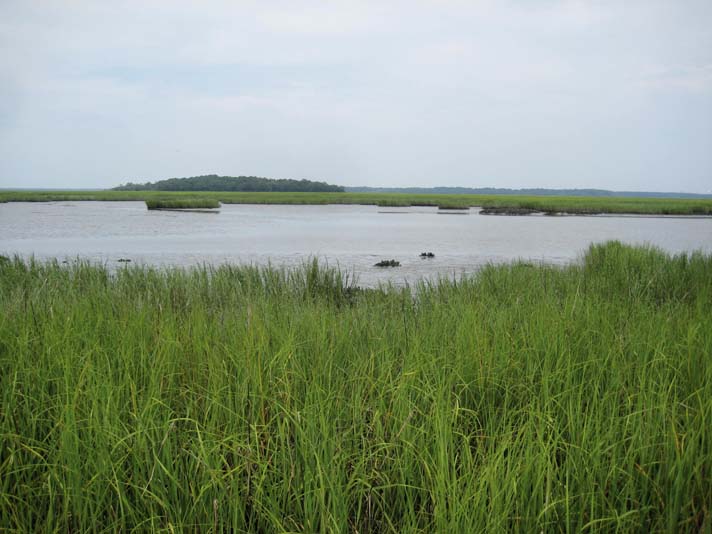
kurt buhlman
Diamondback terrapins (Malaclemys terrapin ssp.) live exclusively in coastal brackish and saltwater marshes of the eastern and southeastern U.S.
I can vividly recall my first experience with the diamondback terrapin. It was Memorial Day weekend, during a family vacation in 1973. We exited the New Jersey Garden State Parkway and took the causeway to Sea Isle City. We were crossing an expansive salt marsh, and just before reaching the bridge over the Intra-coastal Waterway, I saw a female diamondback terrapin traversing the roadway.
I was screaming, “Turtle, turtle!” from the back seat of our 1964 Chevy Nova station wagon, and my dad, having already seen the turtle, was braking hard off the roadway. He ran back and grabbed the terrapin off the road before a line of cars would have certainly smashed it. He handed it to me in the backseat and I studied this turtle that was completely new to me. That terrapin spent the weekend in a Jersey shore motel with us, in the bathtub, and we released it into the Intra-coastal Waterway on our way back home.
My second experience with a diamondback terrapin came during the same trip, on the day my younger sister pulled up a crab trap we had lowered from a wooden dock into the marsh. A smaller terrapin, presumably a male, was in the trap, apparently attracted to the mullet that my dad had tied into the trap as bait for blue crabs. We admired and then released the terrapin, when my mother firmly told me, “We don’t have another bathtub in the motel room.”
As a youngster, I don’t recall understanding that the first terrapin was a female out on the causeway looking for a nesting site, nor did I know how to palpate a turtle to feel for eggs. But I did know that I had never seen this type of turtle before, and by the end of the weekend, I knew that it was a turtle whose home was the salt marsh. I did see a third, fourth and fifth terrapin that weekend. Unfortunately, they were all smashed turtles on the causeway.
Terrapin Threats and Solutions
Over the years, I have had the good fortune of encountering terrapins in the wild and learning about their natural history and their unique role in salt marsh ecosystems.
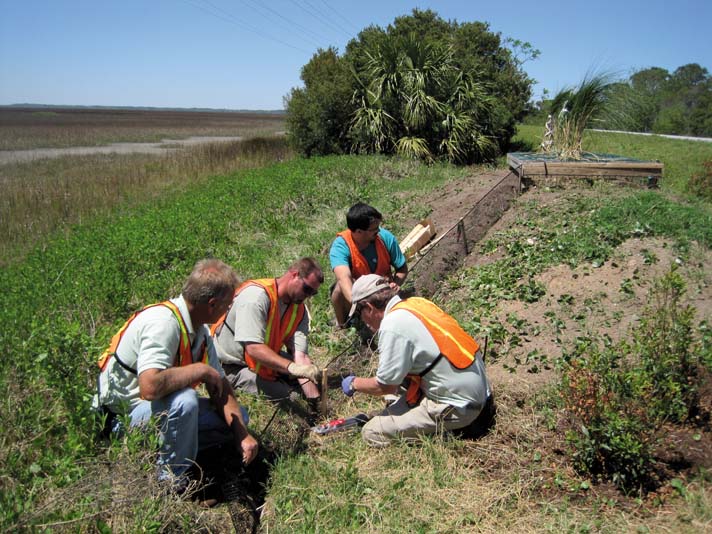
kurt buhlmann
Researchers in Georgia install fencing along the Jekyll Island causeway to help curb terrapin road fatalities.
On Kiawah Island, S.C., as a student of Whit Gibbons, I participated in his mark-recapture study of terrapins in three different salt marsh creeks. What was always interesting was that the same terrapins could be recaptured year after year in the same creeks, proving that they clearly had a home range and site fidelity to a certain creek in the marsh.
Unfortunately, it has become apparent at Kiawah and elsewhere that terrapin populations in individual creeks are subject to extirpation because recreational crab pots left unattended will drown them. Worse, “ghost” crab pots—those whose rope lines to the surface have broken or been forgotten—continue to capture and drown terrapins. Andrew Grosse and colleagues who have published research on the impact of ghost crab pots found as many as 133 drowned terrapins in abandoned traps in just one Georgia salt marsh.
Researchers at the Wetlands Institute in Stone Harbor N.J., as well as elsewhere, have championed the use of terrapin excluders. An excluder is a simple rectangular metal frame measuring 4.75 by 1.75 inches which prevents larger terrapins from entering a crab trap, thus protecting all reproductive females, yet does not reduce blue crab captures. Some, although not all, state wildlife and marine resource agencies now require the excluders.
The causeway across the salt marsh that connects Brunswick, Ga. to Jekyll Island is just one example of a hotspot of female terrapin nesting activity. As you may imagine, it is also a hotspot for road kill. Brian Crawford, as a graduate student at the University of Georgia, found specific areas along the 6-mile causeway where the likelihood of terrapins crossing the causeway was greatest. Because erecting wildlife fencing along the entire length of the causeway would be prohibitively expensive, strategic areas were identified for the placement of shorter fences to reduce mortality of a proportionately greater number of diamondback terrapins.
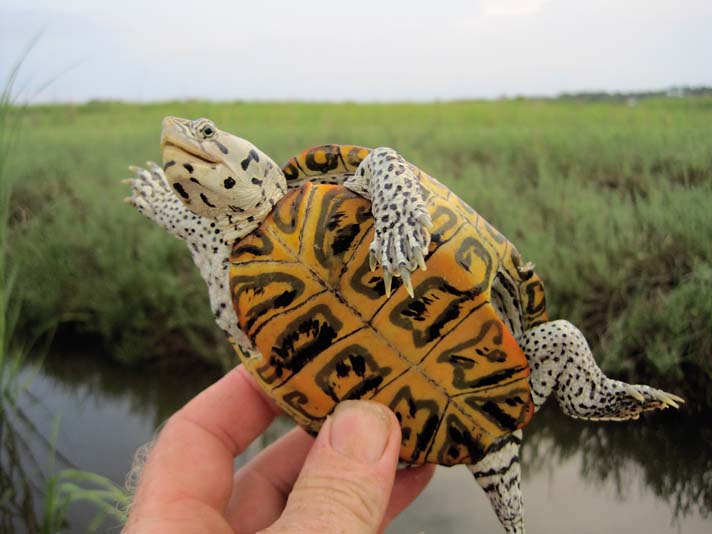
kurt buhlmann
Most terrapins are docile and do not bite people when being held, but a few will if given the chance.
However, fencing terrapins off of salt marsh causeways addresses only a part of the problem. Female terrapins are not really looking to cross these causeways and there are bridges where water flows between marshes on both sides of the roads that allow connectivity of populations on both sides. What female terrapins are looking for is high ground on which to nest, and unfortunately, the center yellow line of a causeway is often the highest ground in a salt marsh. Providing short stretches of fencing along these hotspots while also providing areas of appropriate elevated mounds of nesting substrate between the marsh and the fence will allow the terrapins to nest, and then return to the marsh from the side whence they came, thus preventing mortality of the adult females.
On the causeway to Jekyll Island, Ga., we have been experimenting with possible terrapin conservation solutions for several years. Dan Quinn and colleagues have recently studied the use of the elevated nesting mounds and found that female terrapins will use them if they are placed in the direct line of turtle travel from the marsh toward the causeway. We have designed protected nesting areas that female terrapins can enter, but egg predators, such as raccoons, cannot due to a restricted squeezable space and an electrified wire. For more information on this subject, read upcoming research by Quinn and his colleagues.
Although the human consumption of diamondback terrapins in North America has declined, the demand for terrapins in Asian markets has increased in recent years. Range-wide, declines in terrapin numbers continue from the persistent capture and drowning in recreational and possibly commercial crab traps and also from high annual road mortality of females. Nest predation by subsidized predators, namely raccoons, reduces nest success and lowers hatchling recruitment.
The most effective approach to conservation of diamondback terrapins has been for local coastal communities to address the problem through a combination of regulatory changes (e.g., requiring turtle excluder devices on crab traps), public education and awareness (e.g., posting terrapin crossing signs on roads), fencing to prevent nesting females from gaining access to road surfaces, and safe nesting areas.
Diamondback Terrapin Captive Care
Most terrapins are docile and do not bite people when being held, but a few will if given the chance. Females, especially, given their massive head size and jaw muscles, should be handled with care.
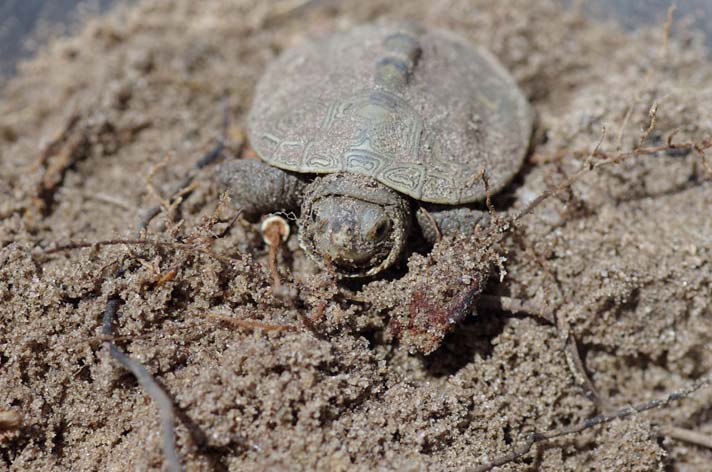
kurt buhlmann
A hatchling diamondback terrapin emerges from a nest. Hatchling terrapins make the best pets, and are often available from turtle breeders.
In the wild, terrapins are almost strictly carnivorous, eating a variety of shellfish, such as periwinkle snails, and crustaceans such as blue crabs. Large females have strong jaws and can crack the shells of larger snails and clams; the smaller males eat smaller prey items. Hatchling terrapins will eat tiny fiddler crabs.
In captivity, most diamondback terrapins will eat commercial turtle diets such as Reptomin. Dried brine shrimp are also favored, and frozen/thawed salad shrimp work well and are less likely to be rejected by picky eaters. Calcium blocks and cuttlebone should be provided to hatchling terrapins to graze upon.
Hatchling diamondback terrapins are the preferred age class for the turtle hobbyist, and they are often available from turtle breeders. Hatchlings are very cute with their big black eyes. Their coloration is generally uniformly gray above with lighter colored plastrons. They are active turtles and tend to grow quickly. Wild-caught terrapins can be high strung and are not recommended for captivity.
Captive hatchling terrapins require clean, clear water with a sufficient filtration system. A 20-gallon long aquarium with 3 to 4 inches of water will comfortably house several. Do keep in mind that terrapins grow quickly, so you will find yourself upgrading to a larger terrapin enclosure fairly soon. A 40-gallon Rubbermaid oval tub will comfortably house a single adult female or two adult males.
Do not overcrowd terrapins, and keep individuals of similar size together. Hatchlings will nip at each other’s tails if crowded, hungry, or if one is bigger than the other.
Poor water quality is the leading cause of health problems in captive diamondback terrapins, and they must have circulating water. Submersible pumps, such as a Fluval 3 (for the 20-gallon aquarium) or a Fluval 4 (for the 40-gallon Rubbermaid tub) should keep the water flowing and clean. The pH should be slightly acidic to neutral, in the range of 6.8 to 7.0. Terrapins like open water and will actively swim, too, but they do need places to hang out. Plastic aquarium plants work well in providing areas for them to grasp onto and rest.
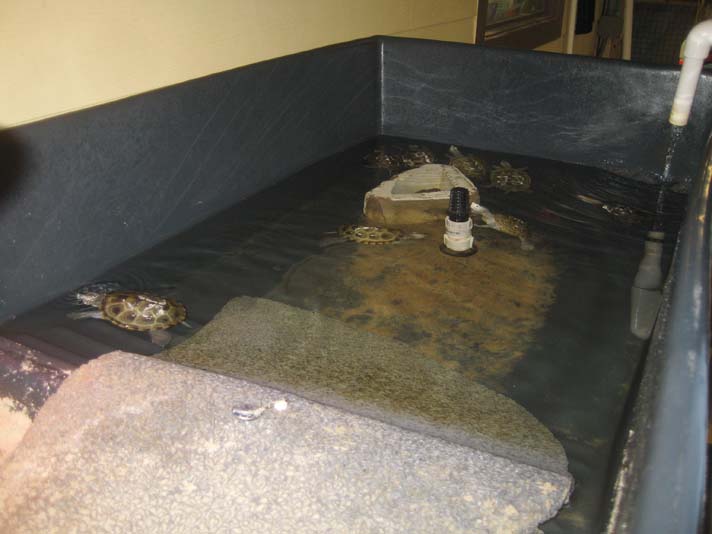
kurt buhlmann
A basking site where your terrapin can completely emerge from the water and completely dry off is a must. Floating basking sites work well for hatchlings, but larger terrapins require a more solidly anchored basking site, such as a log or a ramped board.
Diamondback terrapins tend to be messy eaters, so feeding them in a separate container that can easily be dumped out and cleaned after use will minimize the need to clean the filter in their home enclosures.
A basking site where your terrapin can completely emerge from the water and completely dry off is a must. Floating basking sites work well for hatchlings, but larger terrapins require a more solidly anchored basking site, such as a log or a ramped board. A full-spectrum UV bulb and a 50 to 75-watt basking spotlight should be used over the basking site to maintain its temperature in the mid 80 degrees Fahrenheit. (It is rare to see diamondback terrapins basking in the wild because they are secretive and skittish. They often bask in large numbers on mud flats in hidden sections of tidal creeks.)
Water temperatures should be maintained in the range of 76 to 78 degrees, which for hatchlings can be accomplished by using an underwater glass tube heater. These may be rolled around too much by larger terrapins, so for them, an infrared spotlight on a timer for use at night may help maintain appropriate temperatures. Monitor your setup’s temperatures with a thermometer.
Terrapins will drink freshwater when provided with it. Thus, periodic soakings in freshwater for drinking purposes (which can be accomplished during feeding in a separate container as previously mentioned) coupled with a 25-percent seawater concentration in their home enclosure (see sidebar) might come the closest to optimal captive conditions.
The proper care of diamondback terrapins is a long-term commitment. Males mature at 2 to 3 years of age, females at 4 to 6, and they may live 30 years or longer in the wild. Make sure that you have the space needed for the animals you choose to keep.
Of course, if the necessary space requirements for captive terrapin care are lacking in your house, there is no reason that you cannot still observe beautiful diamondback terrapins in their natural salt marsh environment, perhaps during your next trip to the beach.
Kurt Buhlmann is a senior research associate and conservation ecologist at the University of Georgia’s Savannah River Ecology Laboratory. His research focuses on applied conservation solutions for reptiles and amphibians, including habitat restoration and management, reintroductions and population augmentations, and head-starting projects, particularly with turtles. He has a PhD in ecology from the University of Georgia, an MS in wildlife management from Virginia Tech and a BS in environmental studies from Stockton State College (NJ).


